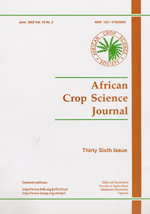
|
African Crop Science Journal
African Crop Science Society
ISSN: 1021-9730
EISSN: 1021-9730
Vol. 27, No. 4, 2019, pp. 687-708
|
 Bioline Code: cs19046
Bioline Code: cs19046
Full paper language: English
Document type: Research Article
Document available free of charge
|
|
|
African Crop Science Journal, Vol. 27, No. 4, 2019, pp. 687-708
| fr |
Nigussie, D.; Mulugeta, W.; Molla, A.; Bishaw, Z. & Biradar, C.
Résumé
La mise à l’échelle réussie de la technologie agricole nécessite un cadre d‘ explicite spatial pour se concentrer sur la bonne variété au bon endroit. Cela implique une approche d’évaluation multicritère (ECM), utilisant un ensemble de facteurs déterminants pour délimiter les domaines de mesurage pour les variétés de féverole ( Vicia faba

L.) et identifier les terres potentiellement appropriées dans une région et une zone spécifiques en Éthiopie. Relever ce défi exigera un cadre spatial certain. L’analyse de l’aptitude des terres est une évaluation et une prise de décision spatiale impliquant plusieurs facteurs déterminants. Les facteurs pris en compte dans cette analyse incluent des paramètres biophysiques clés tels que le climat, la topographie, les types de sol et leurs propriétés. L’analyse a également porté sur les variétés améliorées de féverole, à savoir Dagm, Dosha, Gabelcho, Gora, Hachalu, Moti et Walki. Les couches de facteurs environnementaux d’une valeur de pixel de plante spécifique ont été classifiées et pondérées, puis comparées entre elles pour un classement ultérieur tenant compte de leur importance relative dans la délimitation de domaines d’extrapolation spécifiques à une variété. L’analyse géo-statistique a été réalisée pour estimer l’étendue des zones évolutives. La classification a montré qu’elle convenait parfaitement aux variétés 0,02 million d’hectares pour Dosha; 0,19 pour Gabelcho; 0,11 pour Gora; 0,33 pour Moti; 0,05 pour Dagm; 0,14 pour Hachalu; et 0,26 million d’hectares pour Walki. Les zones moyennement adaptées à ces variétés couvraient respectivement 5,0; 9,4; 7,2; 15,3; 4,6; 8,8 et 7,5 millions d’hectares dans l’ensemble du pays. La plus grande proportion de toutes les variétés était modérément appropriée; alors que la proportion de produits légèrement appropriés était très faible, bien qu’il y ait une assez grande variabilité au sein de chaque variété de féverole en ce qui concerne son adaptation agroécologique aux environnements cibles. De tels cadres spatiaux biophysiques deviennent des points d’entrée essentiels pour l’introduction de profils de produits spécifiques à une variété, ce qui peut être encore amélioré en incorporant des attributs socio-économiques permettant de rentabiliser l’investissement dans la focalisation de la technologie.
Facteurs environnementaux; décision spatiale
|
| |
| en |
GIS-Based multi-criteria land suitability mapping for scaling faba bean varieties in Ethiopia.
Nigussie, D.; Mulugeta, W.; Molla, A.; Bishaw, Z. & Biradar, C.
Abstract
Successful scaling of agricultural technology requires a spatial explicit framework for targeting the right variety at the right place. This entails a multi-criteria evaluation (MCE) approach, using a set of determining factors to delineate the scaling domains for faba bean ( Vicia faba

L.) varieties in and identify potentially suitable land area in a specific region, and zone in Ethiopia. Meeting this challenge will require a solid spatial framework. Land suitability analysis is an evaluation and spatial decision making, involving several determining factors. The factors considered in this analysis include key biophysical parameters such as climate, topography, soil types and properties. The analysis was also focused on improved faba bean varieties viz., Dagm, Dosha, Gabelcho, Gora, Hachalu, Moti and Walki. The environmental factors’ layers of a specific crop pixel values were classified and given a weight, and then compared among themselves for further ranking to account for their relative importance to delineate variety specific extrapolation domains. The geo-statistical analysis was carried out to estimate the extent of the scalable areas. The classification showed that, it was highly suitable for varieties 0.02 million hectares for Dosha; 0.19 for Gabelcho; 0.11 for Gora; 0.33 for Moti; 0.05 for Dagm; 0.14 for Hachalu; and 0.26 million hectares for Walki. Moderately suitable areas for these varieties covered 5.0, 9.4, 7.2, 15.3, 4.6, 8.8, and 7.5 million hectares, respectively across the country. The largest proportion for all varieties was moderately suitable; while the share of slightly suitable was very low, although there was quite variability within each of the faba bean variety in terms of its agro-ecology adaptation to the target environments. Such biophysical spatial frameworks become essential entry points for introducing variety specific product profiles and this can be further enhanced by incorporating socio-economic attributes accounting for return of the investment in targeting the technology.
Environmental factors; spatial decision
|
| |
© Copyright 2019 - African Crop Science Society
|
|
